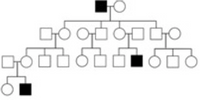
Human Anatomy & Physiology (11th Edition)
11th Edition
ISBN: 9780134580999
Author: Elaine N. Marieb, Katja N. Hoehn
Publisher: PEARSON
expand_more
expand_more
format_list_bulleted
Concept explainers
Topic Video
Question
What is the most likely mode of inheritance of the trait shown in the pedigree?
- Y-linked
- X-linked recessive
- autosomal recessive
- autosomal dominant
- X-linked dominant

Expert Solution
arrow_forward
Step 1 Introduction
Mode of inheritance is the manner in which a genetic trait or disorder is passed from one generation to another.
Trending nowThis is a popular solution!
Step by stepSolved in 2 steps

Knowledge Booster
Learn more about
Need a deep-dive on the concept behind this application? Look no further. Learn more about this topic, biology and related others by exploring similar questions and additional content below.Similar questions
- Y-linked ㅁㅇ O ㅇㅁ In the pedigree shown, indicate whether each of the following inheritance patterns is possible by selecting YES or NO from the appropriate drop down menu. Autosomal Recessive Autosomal Dominant X-linked Recessive X-linked Dominant ◆ 마음 (>> 01arrow_forwardA man affected with HoHomania and a woman affected with HoHomania mate and have an unaffected son. Which of the following mechanisms of inheritance can not be ruled out? Choose all that can not be ruled out. Autosomal Dominant Autosomal Recessive Y-linked All of the mechanisms shown can be ruled out X-linked Recessive X-linked Dominantarrow_forwardAn unaffected man and an unaffected woman mate and have a daughter affected with Fifimania. Which of the following mechanisms of inheritance can not be ruled out? Choose all that can not be ruled out. Autosomal Recessive Autosomal Dominant X-linked Dominant X-linked Recessive All of the mechanisms shown can be ruled out Y-linkedarrow_forward
- Which of the 6 modes is this pedigree and why? 1) Autosomal Dominant 2) Autosomal Recessive 3) X-linked Recessive 4) X - linked Dominant 5) Y-Linked 6) mt-Linkedarrow_forwardIn autosomal dominant inheritance patterns, the trait is present in every generation. True Falsearrow_forwardName: Human Phenotypes Simple dominance inheritance pattern: Q: How many phenotypes are evident in patterns of simple dominance? What are they? If a phenotype results from simple dominance, which two genotypes cannot be distinguished? Which phenotype is always representative of the genotype? Now determine your personal inheritance of the following traits. As you read through the following descriptions, you'll identify your trait, and determine your phenotype. Your trait will be one of the two Shape of the face. Most facial characteristics are affected by many different genes acting together (multiple factors or polygenic inheritance). For this trait we have simplified the nature of this trait by assuming it is the result of a single gene. Oval shape is dominant (needs only homozygous (both alleles are the same, either dominant or recessive) or heterozygous (one dominant allele and one recessive allele). Square shape is recessive (requires that both alleles are the recessive allele in…arrow_forward
- Which of the following is the most likely description of the trait in the following family tree? X-linked Recessive X-linked Dominant Y-linked Autosomal Dominant Autosomal Recessivearrow_forwardGenetic Inheritance Patterms Retinitis pigmentosa (RP) can be autosomal recessive, autosomal dominant, or x-linked. Apparently the dominant forms are often less severe. Eric's form of RP is Usher's Syndrome, which is an autosomal recessive inheritance (i.e., you must get a copy of the defective gene from your Mom and one from your Dad). Autosomal means it is not carried on one of the chromosomes that determines sex. Usher's Type II is recessive, so for Eric this means that both his Mom and Dad are carriers of this condition. His brother, Dirk, does not have any symptoms of RP. Draw a pedigree of Eric's family showing possible genotypes and chances of having RP. Your pedigree must include his parents, Eric, his brother Dirk, and a potential daughter of Eric's. Draws a pedigree that shows the correct genotypes and chances of having retinitis pigmentosa for Eric and his family. D.Focus (United States) a S W 37 F 八 口arrow_forward
arrow_back_ios
arrow_forward_ios
Recommended textbooks for you
 Human Anatomy & Physiology (11th Edition)BiologyISBN:9780134580999Author:Elaine N. Marieb, Katja N. HoehnPublisher:PEARSON
Human Anatomy & Physiology (11th Edition)BiologyISBN:9780134580999Author:Elaine N. Marieb, Katja N. HoehnPublisher:PEARSON Biology 2eBiologyISBN:9781947172517Author:Matthew Douglas, Jung Choi, Mary Ann ClarkPublisher:OpenStax
Biology 2eBiologyISBN:9781947172517Author:Matthew Douglas, Jung Choi, Mary Ann ClarkPublisher:OpenStax Anatomy & PhysiologyBiologyISBN:9781259398629Author:McKinley, Michael P., O'loughlin, Valerie Dean, Bidle, Theresa StouterPublisher:Mcgraw Hill Education,
Anatomy & PhysiologyBiologyISBN:9781259398629Author:McKinley, Michael P., O'loughlin, Valerie Dean, Bidle, Theresa StouterPublisher:Mcgraw Hill Education, Molecular Biology of the Cell (Sixth Edition)BiologyISBN:9780815344322Author:Bruce Alberts, Alexander D. Johnson, Julian Lewis, David Morgan, Martin Raff, Keith Roberts, Peter WalterPublisher:W. W. Norton & Company
Molecular Biology of the Cell (Sixth Edition)BiologyISBN:9780815344322Author:Bruce Alberts, Alexander D. Johnson, Julian Lewis, David Morgan, Martin Raff, Keith Roberts, Peter WalterPublisher:W. W. Norton & Company Laboratory Manual For Human Anatomy & PhysiologyBiologyISBN:9781260159363Author:Martin, Terry R., Prentice-craver, CynthiaPublisher:McGraw-Hill Publishing Co.
Laboratory Manual For Human Anatomy & PhysiologyBiologyISBN:9781260159363Author:Martin, Terry R., Prentice-craver, CynthiaPublisher:McGraw-Hill Publishing Co. Inquiry Into Life (16th Edition)BiologyISBN:9781260231700Author:Sylvia S. Mader, Michael WindelspechtPublisher:McGraw Hill Education
Inquiry Into Life (16th Edition)BiologyISBN:9781260231700Author:Sylvia S. Mader, Michael WindelspechtPublisher:McGraw Hill Education

Human Anatomy & Physiology (11th Edition)
Biology
ISBN:9780134580999
Author:Elaine N. Marieb, Katja N. Hoehn
Publisher:PEARSON

Biology 2e
Biology
ISBN:9781947172517
Author:Matthew Douglas, Jung Choi, Mary Ann Clark
Publisher:OpenStax

Anatomy & Physiology
Biology
ISBN:9781259398629
Author:McKinley, Michael P., O'loughlin, Valerie Dean, Bidle, Theresa Stouter
Publisher:Mcgraw Hill Education,

Molecular Biology of the Cell (Sixth Edition)
Biology
ISBN:9780815344322
Author:Bruce Alberts, Alexander D. Johnson, Julian Lewis, David Morgan, Martin Raff, Keith Roberts, Peter Walter
Publisher:W. W. Norton & Company

Laboratory Manual For Human Anatomy & Physiology
Biology
ISBN:9781260159363
Author:Martin, Terry R., Prentice-craver, Cynthia
Publisher:McGraw-Hill Publishing Co.

Inquiry Into Life (16th Edition)
Biology
ISBN:9781260231700
Author:Sylvia S. Mader, Michael Windelspecht
Publisher:McGraw Hill Education